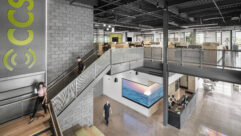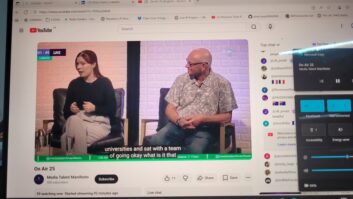NEC HT1000
Feb 1, 2003 12:00 PM,
Jeff Sauer
SPECIFICATIONS
OPTICAL
Panel Single-chip 12-degree DMD
Resolution Multiresolution 1,024×768 XGA; 1,024×576 wide mode Advanced AccuBlend compatible
Lens Manual zoom, manual focus, and manual IRIS, F = 2.5-3.7, f = 22.4-27.0 mm
Light Output 1,000 lumens standard, 800 EcoMode (ANSI, typical)
Lamp Life (up to) EcoMode: 2,000H; Normal mode: 1,500H
Contrast Ratio 3,000:1 with variable IRIS and SweetVision Technology, >2000:1, std.
Image Size 40-200 inches diagonal
ELECTRICAL
Inputs 1 DVI-D; 1 RGB; 1 S-video; 1 video; 1, 3-RCA component video; 1 PC Card; 4 stereo mini audio
Outputs 1 screen trigger, 1 PC control
Video Compatibility NTSC, NTSC4.43, PAL, PAL-M, PAL-N, PAL-60, SECAM, HDTV: 1,080p, 1,080i (24SF support), 720p, SDTV: 576p, 576i, 480p, 480i
Horizontal Resolution NTSC, NTSC4.43, PAL/PAL-M/PAL-N/PAL-60 – 540 TV lines
SECAM – 300 TV lines, Y/Cb/Cr -540 TV lines,
RGB -1,024 pixels (H) × 768 pixels (V)
External Control RS232 (AMX/Crestron compatibility), LAN
Sync Compatibility Separate Sync / Composite Sync / Sync on G
Built-In Speakers 2W×2 with 3-D stereo
Fan Noise EcoMode <29; Normal mode <32
Power Requirements 100-120 VAC/200-240 VAC, 50/60 Hz
Input Current 3.2A (100-120 VAC), 1.6A (200-240 VAC)
Power Consumption 290W, 0.8W in standby
MECHANICAL
Installation Orientation: floor/front, floor/rear, ceiling/front, ceiling/rear
Optional Ceilingmount Bracket Model LT60CM (includes threaded pipe base and flush base)
Dimensions (W×D×H) 10.24×12.56×4.72 inches, 260×319×121 mm (including protrusions)
Net Weight 7.1 lb. (3.2 Kg)
It’s hard to get too excited about many seven-pound projectors these days. For a time, a little more brightness and a little more contrast might best dozens of similar competitors, but incremental improvements hardly stir the senses. What’s more, the hottest projectors are the two-pounders, right? Wrong! If you sell and install video equipment, one of the coolest projectors is NEC’s new 7.1-pound HT1000.
That HT stands for “home theater,” and NEC indeed markets this unit for residential use. But the XGA-resolution HT1000 is an affordable video projector that NEC sees just as comfortably solving the business presentation and entertainment needs of nightclubs, museums, boardrooms, schools, and arcades. Whereas NEC has made plugging and playing easy for home users, the company hasn’t skimped on any of the fine-tuning and administrative features that pro A/V installers will surely demand — even while besting some visually comparable models by a two-to-one price margin.
As competitive as the projector business has been, good video has been surprisingly hard to come by without spending big money on a large piece of equipment. Composite and S-video inputs are an easy add-on for almost all projectors, but the lucrative, if staid, business of showing PowerPoint slides and spreadsheet graphs is looking for lumens, not deinterlacing. Video people have had to take what they’ve been given. Thankfully, that’s changing.
Several projectors in this size class now incorporate Faroudja’s DCDi deinterlacing technology, helping to minimize motion artifacts. Colors are more accurate, and contrast ratios — essential to rich video — are improving across the board. Contrast ratios have become particularly strong in DLP-based projectors.
Still, the deep blacks and perfect colors essential for video often run contrary to that paramount data-projector quest for more brightness. For example, most data-oriented DLP color wheels have a clear section dedicated to increasing brightness, and it’s often larger than the red, green, and blue sections. In extreme cases, the clear section is larger than the three-color sections combined. It’s good for brightness, but not for accurate video.
The HT1000, on the other hand, uses a color wheel with six equal sections of red, green, and blue (two each) in front of Texas Instruments’ (TI’s) latest DDR version of the DLP micromirror device. Throw in NEC’s gimmicky-or-not Vortex and SweetVision marketing names, and the result is top-notch color reproduction, previously the domain of higher-priced three-panel LCD units. Add Faroudja’s DCDi, component inputs, excellent video scaling, a 10-bit video decoder, and some rich blacks and dark grays, and you have an affordable projector that finally lives up the title of video projector.
NEC has opted for a native 4:3 aspect ratio in the HT1000 (1,024 by 768), and that bucks a minor trend for home-theater users expecting superior wide-screen HD video. Here wide-screen resolution drops to a less mathematically perfect 1,024 by 576, though the unit scales to support 16:9, 1.85:1, 2.35:1, and all HDTV resolutions. This isn’t a bad choice overall. First, there’s no worrying about quality from an HD source into the HT1000, at least not at this price point, because NEC’s scaling doesn’t give much away. More importantly, 4:3 is still by far the dominant display ratio for today’s content. That’s true for sports, cable movies, and other television for home viewing — but more to the point for likely commercial end-users.
NEC certainly isn’t targeting home use with the Kensington lock feature that physically locks down all projector functions. Cabinet controls can also be locked out should the unit need to be placed in a public area. Then, for all setup operations, the installer would use the remote or a network connection (through an optional PC Card adapter) for remote computer access to primary projector operations, limited setup controls, and a maintenance monitor.
An entertainment venue or a club is able to store a company logo onboard for use as a startup or as an input-idle splash screen. In addition, there is a digital photo viewer for movie-theater-style advertisements.
The HT1000 also has excellent projector orientation controls, including vertical and horizontal keystone correction. If you’re in wide-screen “screen” mode and thus not utilizing the entire vertical resolution, you can shift the frame up or down. There is even a “cornerstone” — effectively a diagonal keystone — feature for projecting a straight image from a particularly awkward angle. In fact, the drill-down menu options for adjusting image, colors, positioning, screen size, and so on are so thorough that NEC is running the risk of baffling consumers. But it’s a boon for pro A/V users.
Unlike data projectors, for which brightness is king, video projectors must seek balance. Because video viewing is often done in a closed, controlled environment, high brightness isn’t nearly as important as it would be in a sun-filled conference room. It can even detract from the proper mood when watching a movie at home or a sporting event in a nightclub. (Of course, Sunday afternoon football may have to fight ambient sunlight, making too-dark projectors ineffective.)
NEC solves that potential problem through its EcoMode technology, which has had modest appeal in the bright-as-can-be world of data projection. It fits nicely here. EcoMode turns down the lamp, lowering brightness and saving lamp life when the extra brightness is unwanted or simply unnecessary. It also reduces the fan noise to an almost inaudible level.
The HT1000 is rated at 1,000 ANSI lumens at full power, and I actually measured slightly more than that: 1,048 lumens. Switch to EcoMode, and the rating drops down to 800 ANSI lumens (I measured an almost spot-on 811 lumens). More importantly, I actually preferred the lower brightness in a dark room set up for movie watching, though each room, bar, nightclub, or other venue will be different. But that’s a good reason for the option.
The HT1000 did well in the rest of the bench tests. Colors were accurate. Uniformity of 94 percent is solid, though I measured a more middling 85 percent uniformity in EcoMode. Although I didn’t follow whatever testing methodology produced NEC’s claimed 3,000:1 contrast ratio, by the ANSI checkerboard, I did measure a strong 260:1 ratio, 226:1 in EcoMode. Color temperature across a range of gray-scale colors varied by less than 700 degrees K, a far smaller amount than most projectors offer.
A good deal of what makes the HT1000 such an effective video projector is technology that NEC has licensed and incorporated into the unit, like DCDi and TI’s best single-chip DLP effort yet for video.
However, there’s no denying that NEC has incorporated some of its own technology, including color balancing and the optical engine, to produce a high-caliber model. Also, NEC has put it on the market at a solid price. Until someone else can beat the quality and price, HT might as well mean “hello there.”
Jeff Sauer is a contributing editor for Video Systems magazine, a video producer, an industry consultant, and the director of the Desktop Video Group, a video and computer products testing lab in Cambridge, Massachusetts. Contact him at [email protected].
PRODUCT SUMMARY
Company: NEC Technologies; (800) NEC-INFO; www.necvisualsystems.com
Product: HT1000
Pros: Good contrast and excellent color reproduction, thanks in part to TI’s latest DDR version of the DLP micromirror device; many security options; Faroudja’s DCDi deinterlacing technology helps minimize motion artifacts; EcoMode lengthens lamp life and cuts noise.
Cons: Lumens output might not be enough for many ambient light conditions.
Demographic: A/V pros who outfit closed, controlled environments like arcades, nightclubs, and museums for video projection.
Price: $5,495







